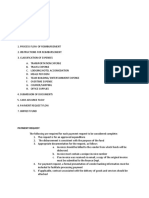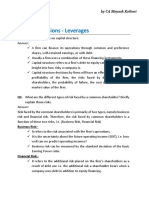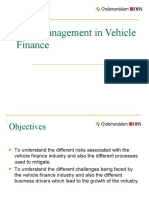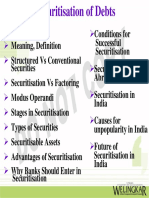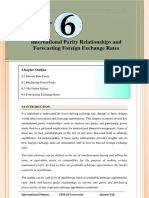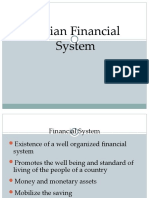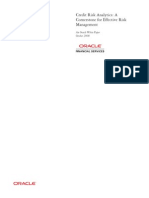Cost of Capital of Mncs
Cost of Capital of Mncs
Uploaded by
Nikhil MukhiCopyright:
Available Formats
Cost of Capital of Mncs
Cost of Capital of Mncs
Uploaded by
Nikhil MukhiOriginal Description:
Copyright
Available Formats
Share this document
Did you find this document useful?
Is this content inappropriate?
Copyright:
Available Formats
Cost of Capital of Mncs
Cost of Capital of Mncs
Uploaded by
Nikhil MukhiCopyright:
Available Formats
A firms capital consists of:
Retained Earnings
Equity (existing or newly issued)
Preferred Stock
Debt (borrowed funds)
The firms cost of retained earnings reflects
the
opportunity cost - what existing shareholders
could
have earned if they invested the funds
themselves.
1
it is the minimum rate of return expected by an
investor.
In other word it is defined as the cost of obtaining the
funds.
It is also called cut off rate, Target rate, Hurdle rate or
minimum required rate of return.
2
Helpful in designing Capital Structure.
Helpful in taking capital budgeting decisions.
Helpful in evaluation of financial efficiency of top
management.
Helpful in comparative analysis of various source of finance.
Helpful in taking other financial decision.
3
4
The firms cost of new equity also reflects an
opportunity cost - what the new shareholders could
have earned if they had invested their funds
elsewhere.
The cost of new equity exceeds the cost of retained
earnings by the floatation costs.
The firms cost of debt increases with the level of
debt.
Increases in the level of debt also increases the
probability of default.
Tax deductibility of interest payments on debts
enhances the attractiveness of debt financing.
A firm must maintain a proper balance between
the tax advantage of debt and its disadvantage
(greater probability of bankruptcy).
The firms weighted average cost of capital
(WACC) can be computed as:
(Total Capital = Debt + Equity + Pref. Stock)
WACC = W
d
K
d
(1-t) + W
p
K
p
+ W
e
K
e
5
where:
D = Proportion of capital (D+E) made
up of debt,
E = The proportion of equity,
K
d
= Cost of debt,
K
e
= Cost of Equity and
t = tax rate.
6
( )
e d
K
E D
E
t K
E D
D
WACC
|
.
|
\
|
+
+
|
.
|
\
|
+
= 1
Capital Asset Pricing Method: This method
takes risk free rate of return and the risk
factor is added while calculating cost of
equity capital.
Retained earning have Opportunity Cost.
Kr= Ke( 1- %Brokerage)
7
8
Size of the Firm: The larger the size of the firm,
the larger the amount that is borrowed. In
addition, larger issues of stocks or bonds allow
for reduced percentage flotation costs.
Access to International Capital Markets: Access
to international capital markets allows MNCs to
attract funds at lower costs than purely
domestic firms.
International Diversification: Diversified cash
flow sources result in more stable cash inflows
for MNCs which may reduce the probability of
bankruptcy and therefore reduce the cost of
capital.
9
Exposure to Exchange Rate Risk: Firms that
are highly exposed to exchange rate risk
may experience greater cash inflow
volatility.
However, exposure to a basket of
currencies will mitigate or eliminate such a
problem.
Exposure to Country Risks: To the extent to
which country risks are not diversifiable,
increased cash inflow volatility may result
with attendant higher cost of capital.
10
11
Cost of Capital Across Countries:
Variations in the cost of capital across countries may help
to explain why MNCs are able to adjust their international
operations and sources of funds.
Differences in the cost of each capital component across
countries may explain why MNCs based in some
countries use more debt-intensive capital structure than
MNCs based elsewhere.
Differences in the Risk-Free Interest Rate:
The risk-free rate is frequently proxied by the yield on
3-month T-bills.
The rate is determined by supply and demand conditions
in each country, tax laws, monetary policies,
demographics, and economic conditions.
12
Differences in the Risk Premium:
The risk premium is affected by the relationship between
borrowers and creditors (e.g.. Japans Keiretsu), and the
propensity of governments to intervene and rescue ailing
or failing firms (compare US. to UK).
Also firms in some countries have greater borrowing
capacity because creditors are tolerant of higher degrees
of financial leverage (e.g. Japanese and German firms
have higher degrees of financial leverage than US. firms).
Country Differences in the Cost of Equity:
The cost of equity is related to investment opportunities
in each country.
In a country with many investment opportunities,
potential returns may be relatively high resulting in a
relatively high opportunity cost of funds.
International Differences in Cost of Equity
Capital
Effectiveness of a Countrys Legal Institutions:
Well-functioning legal systems protect
investors, reduce monitoring and enforcement
costs to investors, reduces a firms cost of
capital by leveling the playing field among
investors.
Differences in Securities Regulation:
Requirement of, and enforcement of, certain
financial disclosures help to reduce asymmetric
information between the firm and its investors
and among investors.
13
Conform to the capital structure of Parent
Company.
Reflect the capitalization norm of each
foreign country
Vary to take advantage of opportunities to
minimize the MNCs cost of capital.
14
Some of the firm specific characteristics that
affect MNCs capital structure include:
Stability of MNCs cash flows.
MNC credit risk - a MNC with assets
acceptable
as collateral has greater access to loans.
Level of retained earnings.
15
Entry and cross-border barriers to investing.
Interest rates in host countries are affected
by capital controls, tax rates & country risks.
A MNCs preference for debt or equity may
depend
on relative costs in a particular country.
Host country currency innovations.
Country risks.
Relative tax laws.
16
MNCs may deviate from their target capital
structure in host countries but still able to
achieve their target capital structure on a
consolidated basis.
i.e., MNCs may ignore local target capital
structure in favor of a global target capital
structure.
17
When MNCs allow (or are forced to allow)
foreign subsidiaries to issue stocks to local
investors, such a subsidiary becomes partially
owned by the parent.
This can affect MNCs capital structure.
In some countries, a MNC will be allowed to
establish a subsidiary only if it meets the
minimum percentage of ownership by local
investors.
A minority interest in a subsidiary by local
investors may, however, offer some protection
against threats of any adverse action by the
host government.
18
Firms in Japan and Germany tend to use a
higher degree of financial leverage than U.S or
U.K firms.
The system of interlocking ownership in Japan
may encourage a greater use of leverage.
Other International Factors
Stock restrictions in host countries
Interests rates in host countries
Strength of host country currencies
Country risk in host countries
Tax laws in host countries
19
You might also like
- Introduction To Forward Exchange Contracts and Their Relevance in Global BusinessDocument22 pagesIntroduction To Forward Exchange Contracts and Their Relevance in Global Businessakashsingh30898No ratings yet
- Process Flow of Payment RequestDocument9 pagesProcess Flow of Payment Requestrowena balaguer100% (1)
- 02 Oct 2013 Fact SheetDocument1 page02 Oct 2013 Fact SheetfaisaladeemNo ratings yet
- 3-7gbr 2006 Dec ADocument12 pages3-7gbr 2006 Dec AAqsa Waseem100% (2)
- Tandon CommitteeDocument6 pagesTandon CommitteeSakthi Priyadharshini MNo ratings yet
- Capital Structure Theory - Net Operating Income ApproachDocument6 pagesCapital Structure Theory - Net Operating Income ApproachDhruv JoshiNo ratings yet
- Question: What Are The Functional Areas Of: Financial Management?Document3 pagesQuestion: What Are The Functional Areas Of: Financial Management?Madhubala SinghNo ratings yet
- Corporate Financing and Valuation-1Document14 pagesCorporate Financing and Valuation-1Ashish pariharNo ratings yet
- Theory of Capital Structure (Assigement - 1) .Document7 pagesTheory of Capital Structure (Assigement - 1) .Ritesh Singh RathoreNo ratings yet
- BCG ApproachDocument2 pagesBCG ApproachAdhityaNo ratings yet
- Analyzing Forex Exposure of Infosys: CIA-1 OF International Financial ManagementDocument12 pagesAnalyzing Forex Exposure of Infosys: CIA-1 OF International Financial ManagementNehal SharmaNo ratings yet
- Final PPT IrdaDocument20 pagesFinal PPT Irdachetankhanna93No ratings yet
- Cost of CapitalDocument16 pagesCost of CapitalParth BindalNo ratings yet
- Ifim Unit 1 - NotesDocument17 pagesIfim Unit 1 - NotesJyot DhamiNo ratings yet
- Mergers and Acquisitions Diventures: Reporters: Jessica Belga-Rabo July Ann ReambonDocument9 pagesMergers and Acquisitions Diventures: Reporters: Jessica Belga-Rabo July Ann ReambonJessica RaboNo ratings yet
- Ohlson 2007Document10 pagesOhlson 2007mzurzdcoNo ratings yet
- Management of Funds Entire SubjectDocument85 pagesManagement of Funds Entire SubjectMir Wajahat Ali100% (1)
- Theories of MergersDocument17 pagesTheories of MergersGarima Singh100% (2)
- Chapter 6 Types of Leverages-1Document23 pagesChapter 6 Types of Leverages-1Aejaz MohamedNo ratings yet
- Issue ManagementDocument194 pagesIssue ManagementBubune KofiNo ratings yet
- Capital Structure and Dividend TheoriesDocument16 pagesCapital Structure and Dividend Theoriesmusa_scorpionNo ratings yet
- Risk Management in Vehicle FinanceDocument19 pagesRisk Management in Vehicle FinanceAbhishek BoseNo ratings yet
- Importance of Mutual FundsDocument14 pagesImportance of Mutual FundsMukesh Kumar SinghNo ratings yet
- Leverage My PptsDocument34 pagesLeverage My PptsMadhuram SharmaNo ratings yet
- Debt Market in IndiaDocument5 pagesDebt Market in IndiaBasavaraju K R100% (1)
- Tax Planning and ManagementDocument12 pagesTax Planning and ManagementPalash BairagiNo ratings yet
- Chapter 08Document16 pagesChapter 08piyu100% (1)
- Dividends - and - Share - Repurchases - Basics - SlidesDocument19 pagesDividends - and - Share - Repurchases - Basics - Slideszaheer9287No ratings yet
- Techniques For Managing ExposureDocument26 pagesTechniques For Managing Exposureprasanthgeni22100% (1)
- Valuation of Merger ProposalDocument21 pagesValuation of Merger ProposalKARISHMAATA2100% (2)
- Capital StructureDocument4 pagesCapital StructurenaveenngowdaNo ratings yet
- External Sources of FinanceDocument18 pagesExternal Sources of FinanceMonika ThakurNo ratings yet
- CH-6-Efficient Capital MarketsDocument9 pagesCH-6-Efficient Capital MarketsMoin khanNo ratings yet
- Valuation of GoodwillDocument10 pagesValuation of Goodwilllekha1997No ratings yet
- NAVDocument27 pagesNAVSai PrintersNo ratings yet
- Sapm PPT 1 - Introduction To InvestmentDocument57 pagesSapm PPT 1 - Introduction To InvestmentNithin Mathew Jose MBA 2020No ratings yet
- Portfolio Management TheoryDocument40 pagesPortfolio Management Theorymohammedakbar88100% (1)
- A 2 - Roles and Functions of Various Participants in Financial MarketDocument2 pagesA 2 - Roles and Functions of Various Participants in Financial MarketOsheen Singh100% (1)
- International Parity Relationships and FDocument12 pagesInternational Parity Relationships and FIqbal CaesariawanNo ratings yet
- Capital Structure and Its Impact On ProfitabilityDocument26 pagesCapital Structure and Its Impact On ProfitabilityRajesh Mer100% (1)
- Financial Markets HMC CaseDocument7 pagesFinancial Markets HMC Casepradhu1No ratings yet
- Chap 009Document22 pagesChap 009Yarlagadda GayathriNo ratings yet
- Samnidhy Faq'sDocument4 pagesSamnidhy Faq'sSourav DharNo ratings yet
- Accounting NYIF Module Quiz 2 With AnswersDocument3 pagesAccounting NYIF Module Quiz 2 With AnswersShahd Okasha100% (1)
- Capital Structure: Theory and PolicyDocument31 pagesCapital Structure: Theory and PolicySuraj ShelarNo ratings yet
- Mutual Funds: Answer Role of Mutual Funds in The Financial Market: Mutual Funds Have Opened New Vistas ToDocument43 pagesMutual Funds: Answer Role of Mutual Funds in The Financial Market: Mutual Funds Have Opened New Vistas ToNidhi Kaushik100% (1)
- AFM Question Bank For 16MBA13 SchemeDocument10 pagesAFM Question Bank For 16MBA13 SchemeChandan Dn Gowda100% (1)
- Risk Damodaran PDFDocument55 pagesRisk Damodaran PDFMiguel RevillaNo ratings yet
- Esop MLPDocument26 pagesEsop MLPYohanes Widi SonoNo ratings yet
- Financial ServicesDocument77 pagesFinancial ServicesGiridhara Raju80% (5)
- Part II Interest Rates and TVM (Revised For 2e)Document68 pagesPart II Interest Rates and TVM (Revised For 2e)Harun MusaNo ratings yet
- Is Interest-Free Intragroup Financing Acceptable?: Smart Decisions. Lasting Value. Audit / Tax / AdvisoryDocument8 pagesIs Interest-Free Intragroup Financing Acceptable?: Smart Decisions. Lasting Value. Audit / Tax / AdvisoryPARTI KEADILAN RAKYAT NIBONG TEBALNo ratings yet
- Anti Takeover Amendments - MergersDocument7 pagesAnti Takeover Amendments - MergersBalajiNo ratings yet
- Legal Procedure of Merger and AcquisitionDocument2 pagesLegal Procedure of Merger and AcquisitionMayank Goyal67% (3)
- Fin 501 Payout PolicyDocument14 pagesFin 501 Payout Policyovi_hassan74No ratings yet
- Operating ExposureDocument31 pagesOperating ExposureMai LiênNo ratings yet
- Different Types of Finance: (Anoushka Agarwal-1920234)Document3 pagesDifferent Types of Finance: (Anoushka Agarwal-1920234)bts forever0% (1)
- Unit-2 Investment AppraisalDocument47 pagesUnit-2 Investment AppraisalPrà ShâñtNo ratings yet
- Dividend Assignment ReportDocument20 pagesDividend Assignment ReportSadia Afroz LeezaNo ratings yet
- Meaning of DerivDocument21 pagesMeaning of DerivNikhil Mukhi100% (1)
- FIM Unit 1Document8 pagesFIM Unit 1Nikhil MukhiNo ratings yet
- Working Capital Management For MNCs - STDocument13 pagesWorking Capital Management For MNCs - STNikhil Mukhi100% (1)
- Advance Tour PlanDocument1 pageAdvance Tour PlanNikhil MukhiNo ratings yet
- Partnership DeedDocument4 pagesPartnership DeeddeltonmukoyakuyaNo ratings yet
- Salary Account Presentation - GICDocument6 pagesSalary Account Presentation - GICSandeep kumar TanwarNo ratings yet
- Icfai Model PapersDocument23 pagesIcfai Model Papersshubhamjain45No ratings yet
- Republic Act 9700Document24 pagesRepublic Act 9700ghernocomNo ratings yet
- Research Paper On Bitcoin Mufti Faraz AdamDocument55 pagesResearch Paper On Bitcoin Mufti Faraz AdamZaini ZainuddinNo ratings yet
- Week 2 Chapter 9Document8 pagesWeek 2 Chapter 9Sahaja SarvaNo ratings yet
- Tax Invoiced L 1171809 BP 37881Document1 pageTax Invoiced L 1171809 BP 37881BeachStreet Eco Resort & SpaNo ratings yet
- Positive Accounting Theory (PAT)Document9 pagesPositive Accounting Theory (PAT)Ikhmil Farisz100% (1)
- Jarislowsky Fraser International Equity Segregated Fund - 2023 - SepDocument1 pageJarislowsky Fraser International Equity Segregated Fund - 2023 - Sepsmartinvest2011No ratings yet
- Engineering Economic Analysis 13th Edition (eBook PDF) All Chapters Instant DownloadDocument55 pagesEngineering Economic Analysis 13th Edition (eBook PDF) All Chapters Instant Downloadniasurada100% (1)
- Tanzania Padnew 05302018Document148 pagesTanzania Padnew 05302018BrianNo ratings yet
- CharlieMoon TheUltimateGuideToTradingWithAI2024Document28 pagesCharlieMoon TheUltimateGuideToTradingWithAI2024songjinjannNo ratings yet
- Tcs Doc Check ListDocument9 pagesTcs Doc Check ListSantosh KumarNo ratings yet
- Credit Risk Analytics White PaperDocument8 pagesCredit Risk Analytics White PaperAvik BanerjeeNo ratings yet
- Minimum Engineering Study Requirements PDFDocument12 pagesMinimum Engineering Study Requirements PDFkselvan_1No ratings yet
- Notes - Inspire Academy - Volume-1 Cs ExecutiveDocument442 pagesNotes - Inspire Academy - Volume-1 Cs ExecutiveSakshi AgrawalNo ratings yet
- FLATPEBBLEDocument9 pagesFLATPEBBLERasika Dhiman100% (1)
- Hamidah Karil-02Document19 pagesHamidah Karil-02Aprilda Ariana SianturiNo ratings yet
- CCCL 2013 2014annual - Report.76 77Document2 pagesCCCL 2013 2014annual - Report.76 77Rashed MalikNo ratings yet
- Common Stock Valuation ModelsDocument1 pageCommon Stock Valuation ModelsShiblyNo ratings yet
- AS 11 & AS 13 QuestionsDocument2 pagesAS 11 & AS 13 QuestionsRambabu SoniNo ratings yet
- Telebirr ReceiptDocument1 pageTelebirr Receiptmig.tig1No ratings yet
- 2011 MAR Mock Mid-Term Test (1) For ACC1701Document4 pages2011 MAR Mock Mid-Term Test (1) For ACC1701Shizuku mizutaniNo ratings yet
- Growing The Global Economy Through SmesDocument44 pagesGrowing The Global Economy Through SmesYunho Dela TorreNo ratings yet
- Chapter 4Document15 pagesChapter 4Arun Kumar SatapathyNo ratings yet
- CH13 Mish11ge EMBFMDocument12 pagesCH13 Mish11ge EMBFMZeeruanNo ratings yet
- Prelim Exam in Financial ManagementDocument2 pagesPrelim Exam in Financial ManagementChristelle JosonNo ratings yet
- AC1025 ZB Exam Paper - May 2023Document20 pagesAC1025 ZB Exam Paper - May 2023sypteqNo ratings yet
- Definition of Business PolicyDocument5 pagesDefinition of Business PolicyJessica LaguatanNo ratings yet

